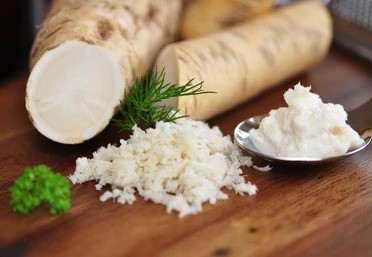Beat the heat with horseradish

COLUMBIA, Mo. — There is scientific evidence suggesting that eating something spicy on a hot summer day will make you feel cooler, says University of Missouri horticulturist David Trinklein.
“Consuming spicy foods leads to a phenomenon known as ‘gustatory facial perspiration,’ which ostensibly cools the body more quickly than a cold glass of lemonade or an ice cream cone,” Trinklein said in a press release. “So, you might consider reaching for the horseradish sauce as a novel way to keep cool this summer.
“Whatever its effect on cooling might be, horseradish is an interesting plant that serves as the source of a condiment enjoying newfound popularity nationwide.”
The Horseradish Information Council has dubbed it “America’s favorite root.”
Native to southeastern Europe and western Asia, horseradish is a perennial member of the Brassicaceae (mustard) family. Although its leaves are edible, it primarily is grown for its fleshy, pungent roots. Its common name is puzzling since it has nothing to do with horses and is not a radish, said Trinklein.
The German word for horseradish is “Meerrettich” (sea radish), since it grows by the sea and, like radish, bears a large storage root. The English began calling it “mareradish”. Over centuries, “mare” became “horse,” giving the plant the common name by which we know it today.
Use of horseradish dates back at least 3,000 years. Some ancients used horseradish syrup as a cough medicine, while others were convinced it cured ailments such as rheumatism and tuberculosis, Trinklein said. Early Greeks, who considered horseradish to be worth its weight in gold, used it as an ointment for back pain and as an aphrodisiac.
The appreciation of horseradish as food is believed to have originated in Europe, he said. During the Renaissance, horseradish consumption spread from central Europe north to Scandinavia and west to England. By the late 17th century, English commoners and laborers used horseradish as a standard condiment, especially to accompany beef and oysters. From England, it was taken to North America during colonial times.
In the U.S., commercial production of horseradish began in the mid-19th century on small farms in the Midwest. Today, Illinois produces more horseradish than any other state, said Trinklein.
A little horseradish goes a long way, and most families need only a few plants. Horseradish is propagated in early spring from 8- to 9-inch root cuttings that contain a growing point, usually saved from the previous fall’s harvest.
To plant, form a trench 3-5 inches deep. Place cuttings 12-15 inches apart at 45-degree angles. Face all in the same direction. Cover the bottom portion of the cuttings with soil to hold them in place.
Horseradish grows best in a deep, rich soil that is moist and fertilized. Fertilize by adding manure in the fall before planting the following spring. Add synthetic fertilizers in the spring if you want, but avoid fertilizers that are high in nitrogen. Once roots establish, irrigation usually is not necessary until later in the growing season when the storage roots begin to enlarge.
The greatest amount of root growth occurs during late summer or early fall when temperatures are relatively mild. Harvest by digging the roots in late October or early November after frost. Dig roots anytime during the winter as long as the soil is not frozen.
Horseradish is relatively pest-free. Flea beetles and beet leaf hoppers are its primary insect pests. “White rust, turnip mosaic and brittle root are diseases known to be problematic on horseradish,” Trinklein said.
Freshly dug, intact horseradish roots lack aroma. When cut or grated, however, enzymes convert a compound in the roots called sinigrin into allyl isothiocyanate, or mustard oil. This is responsible for the “fire” in horseradish sauce. It also can irritate the eyes and sinuses.
Prepare horseradish sauce in a well-ventilated area. Fumes are very strong. Peel and dice roots. Grind roots in a home food grinder, blender or processor. Keep the mixture cool by adding a small amount of water or crushed ice. “Oddly, horseradish needs to be kept cold to stay hot,” said Trinklein.
After the sauce is the proper consistency to eat, add about 2-3 teaspoons of white wine vinegar per cup of ground horseradish. The vinegar stabilizes the heat of the finished product. Add the vinegar promptly for a milder product, or wait several minutes for a greater pungency. Sauce discolors and becomes bitter if you wait too long.
Put the mixture in tightly sealed jars and refrigerate or freeze.
Miss Clipping Out Stories to Save for Later?
Click the Purchase Story button below to order a print of this story. We will print it for you on matte photo paper to keep forever.

